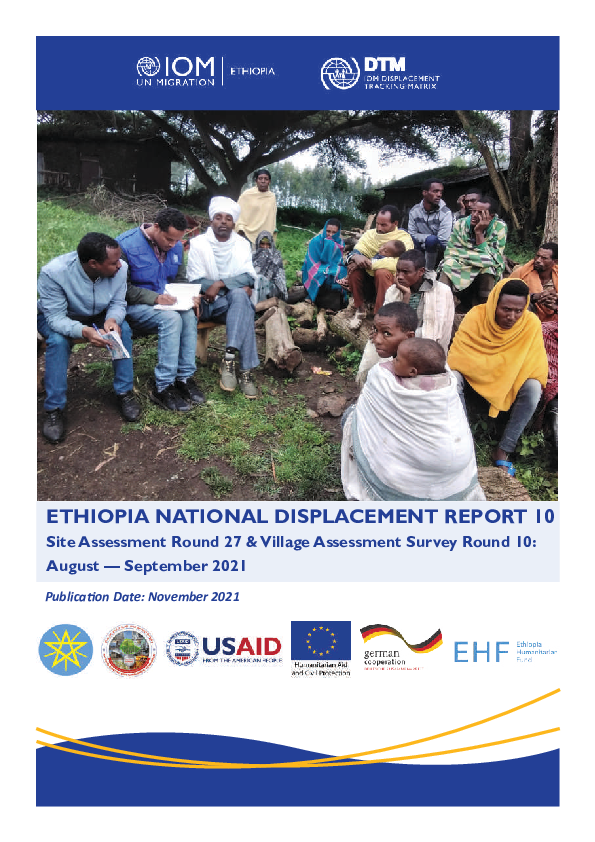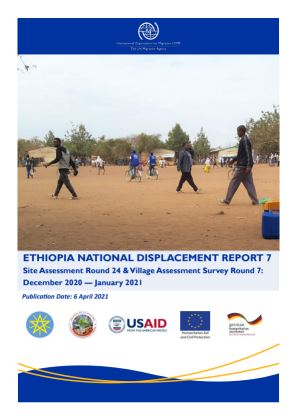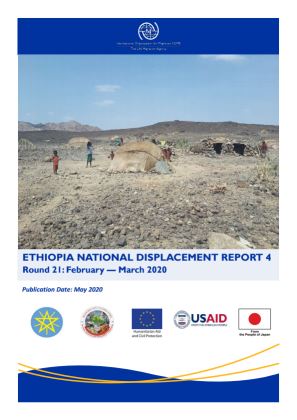-
Countries
-
Data and Analysis
-
Special Focus
-
Crisis Responses
National Displacement Report
Country
Title Standard
Ethiopia — National Displacement Report # (DATE)
Operation
Contact
DTM Ethiopia, DTMEthiopia@iom.int
Type
Component
Domain
Confidential

Contact
DTM Ethiopia, SLOAddisAbabaDTM@iom.int
Language
English
Location
Ethiopia
Period Covered
Aug 15 2021
Sep 23 2021
Activity
- Site Assessment
- Mobility Tracking
- Village Assessment
In order to capture the displacement and return dynamics in Ethiopia, DTM Ethiopia's National Displacement Report combines findings from its Site Assessment (SA) in Section 1 and findings from the Village Assessment Survey (VAS) in Section 2. The Site Assessment tracks the number and multi sectoral needs of internally displaced persons (IDPs), while the Village Assessment Survey tracks the number of IDPs who are returning or have returned to their communities and their multi sectoral needs. VAS is also used to evaluate the absorption capacity of villages receiving returns with a focus on accessibility of services, livelihoods and reintegration.
As of September 2021, a total of 4.23 million IDPs have been identified thus far across the country. Through Site Assessment (SA), a total of 2.12 million IDPs were identified in 1,577 sites across 9 regions in Ethiopia. Simultaneously, 2.11 million IDPs were also tracked through the Emergency Site Assessment (ESA) round 8 which is a monthly tool used to track internal displacement in Tigray, Afar and Amhara regions caused by the Northern Ethiopia Crisis. Of the total displaced population, the main causes of displacement were conflict which displaced 3.5 million IDPs (85%), drought which displaced 307,871 IDPs (7%) and seasonal floods which displaced 139,199 IDPs (3%).
Through Village Assessment Survey, a total of 1.5 million returning IDPs were identified in 1,172 villages across 9 regions. A large majority of returning IDPs (1.4 million) were initially displaced due to conflict while 61,295 returning IDPs were initially displaced due to flash floods and 54,095 returning IDPs due to seasonal floods. The region hosting the largest number of returning IDPs was Oromia region with 653,549 returning IDPs, followed by Somali region with 392,286 returning IDPs. However, please note that there were considerable access and/or security issues in Amhara, Benishangul Gumz, Oromia and Tigray regions which affected the total displacement and return count.

Contact
DTM Ethiopia, SLOAddisAbabaDTM@iom.int
Language
English
Location
Ethiopia
Period Covered
Jun 01 2021
Jul 09 2021
Activity
- Mobility Tracking
- Site Assessment
- Village Assessment
In order to capture the displacement and return dynamics in Ethiopia, DTM Ethiopia's National Displacement Report combines findings from its Site Assessment (SA) in Section 1 and findings from the Village Assessment Survey (VAS) in Section 2. The Site Assessment tracks the number and multisectoral needs of internally displaced persons (IDPs), while the Village Assessment Survey tracks the number of IDPs who are returning or have returned to their communities and their multisectoral needs. VAS is also used to evaluate the absorption capacity of villages receiving returns with a focus on accessibility of services, livelihoods and reintegration.
As of July 2021, a total of 4.17 million IDPs have been identified thus far across the country. Through Site Assessment (SA), a total of 2.07 million IDPs were identified in 1,580 sites across 10 regions in Ethiopia. Simultaenously, 2.1 million IDPs were also tracked through the Emergency Site Assessment (ESA) round 7 which is a monthly tool used to track internal displacement in Tigray, Afar and Amhara regions caused by the Northern Ethiopia Crisis. Of the total displaced population, the main causes of displacement were conflict which displaced 3.5 million IDPs (84%), drought which displaced 308,607 IDPs (7%), flash floods which displaced 157,522 IDPs (4%) and seasonal floods which displaced 112,469 IDPs (3%).
Through Village Assessment Survey, a total of 1.3 million returning IDPs were identified in 1,180 villages across 10 regions. A large majority of returning IDPs (1.2 million) were initially displaced due to conflict while 56,280 returning IDPs were initially displaced due to seasonal floods and 55,039 returning IDPs due to flash floods. The region hosting the largest number of returning IDPs was Oromia region with 672,315 returning IDPs, followed by Somali region with 387,128 returning IDPs. However, please note that there were considerable access and/or security issues in Amhara, Benishangul Gumz, Oromia and Tigray regions which affacted the total displacement and return count.

Contact
DTM Ethiopia, SLOAddisAbabaDTM@iom.int
Language
English
Location
Ethiopia
Period Covered
Mar 01 2021
Apr 11 2021
Activity
- Mobility Tracking
- Site Assessment
- Village Assessment
In order to capture the displacement and return dynamics in Ethiopia, DTM Ethiopia's National Displacement Report combines findings from its Site Assessment (SA) in Section 1 and findings from the Village Assessment Survey (VAS) in Section 2. The Site Assessment tracks the number and multisectoral needs of internally displaced persons (IDPs), while the Village Assessment Survey tracks the number of IDPs who are returning or have returned to their communities and their multisectoral needs. VAS is also used to evaluate the absorption capacity of villages receiving returns with a focus on accessibility of services, livelihoods and reintegration.
Through Site Assessment (SA), a total of 1.96 million IDPs were identified in 1,379 sites across 11 regions in Ethiopia. Conflict displaced an estimate of 1.25 million IDPs, followed by drought which displaced 318,992 IDPs, flash floods which displaced 156,815 IDPs and seasonal floods which displaced 113,388 IDPs, among other displacement reasons.
During the same period, a total of 1.99 million IDPs were also tracked through the Emergency Site Assessment (ESA) round 6 which is a monthly tool used to track internal displacement in Tigray, Afar and Amhara regions caused by the crisis in Northern Ethiopia. Combining the SA and ESA figures brings the total to 3.95 million IDPs identified throughout the country thus far. However, kindly note that there were substantial access and/or security issues throughout Tigray region, Metekel zone in Benishangul Gumz region, the Wallegas, the Hararges, West Guji and Guji zones in Oromia region.
Through Village Assessment Survey, a total of 1.5 million returning IDPs were identified in 1,421 villages across 10 regions. A large majority of returning IDPs (1.4 million) were initially displaced due to conflict while 67,842 returning IDPs were initially displaced due to seasonal floods and 55,214 returning IDPs due to flash floods. The region hosting the largest number of returning IDPs was Oromia region with 714,493 returning IDPs, followed by Somali region with 406,830 returning IDPs.

Contact
DTM Ethiopia, SLOAddisAbabaDTM@iom.int
Language
English
Location
Ethiopia
Period Covered
Dec 01 2020
Jan 11 2021
Activity
- Mobility Tracking
- Site Assessment
- Village Assessment
In order to capture the displacement and return dynamics in Ethiopia, DTM Ethiopia's National Displacement Report combines findings from its Site Assessment (SA) in Section 1 and findings from the Village Assessment Survey (VAS) in Section 2. The Site Assessment tracks the number and multisectoral needs of internally displaced persons (IDPs), while the Village Assessment Survey tracks the number of IDPs who are returning to their communities and their multisectoral needs. VAS is also used to evaluate the absorption capacity of villages receiving returns with a focus on accessibility of services, livelihoods and reintegration. Notably, the impact of COVID-19 on IDPs and villages hosting returning IDPs was also evaluated this round.
Through Site Assessment (SA), a total of 1.96 million IDPs were identified in 1,222 sites across 11 regions in Ethiopia. Conflict displaced an estimate of 1.2 million IDPs, followed by drought which displaced 331,963 IDPs and seasonal floods which displaced 169,662 IDPs, among other displacement reasons. During the same period, a total of 131,590 IDPs were also tracked through the Emergency Site Assessment (ESA) round 2 which is a monthly tool used to track internal displacement in Tigray, Afar and Amhara regions caused by the crisis in Northern Ethiopia. This was also the first time DTM conducted its Site Assessment tool in Addis Ababa, thus tracking internal displacement in every region in Ethiopia for the first time. Combining the SA and ESA figures brings the total to 2.1 million IDPs identified throughout the country thus far. However, kindly note that there were substantial access and/or security issues throughout Tigray region, Metekel zone in Benishangul Gumz region, the Wallegas and the Hararges in Oromia region and Sheka zone in SNNP region.
Through Village Assessment Survey, a total of 1.5 million returning IDPs were identified in 1,381 villages across 9 regions. A large majority of returning IDPs (1.4 million) were initially displaced due to conflict while 47,122 returning IDPs were initially displaced due to flash floods and 35,522 returning IDPs due to seasonal floods. The region hosting the largest number of returning IDPs was Oromia region with 821,653 returning IDPs, followed by Somali region with 408,741 returning IDPs.

Contact
DTM Ethiopia, SLOAddisAbabaDTM@iom.int
Language
English
Location
Ethiopia
Period Covered
Aug 15 2020
Sep 20 2020
Activity
- Mobility Tracking
- Site Assessment
- Village Assessment
In order to capture the displacement and return dynamics in Ethiopia, DTM Ethiopia's National Displacement Report combines findings from its Site Assessment (SA) in Section 1 and findings from the Village Assessment Survey (VAS) in Section 2. The Site Assessment tracks the number and multisectoral needs of internally displaced persons (IDPs), while the Village Assessment Survey tracks the number of IDPs who are returning to their communities and their multisectoral needs. VAS is also used to evaluate the absorption capacity of villages receiving returns with a focus on accessibility of services, livelihoods and reintegration. Notably, the impact of COVID-19 on IDPs and villages hosting returning IDPs was also evaluated this round.
Through the Site Assessment which was conducted from 15 August to 20 September 2020, DTM captured 1,846,551 IDPs (344,782 households) in 1,346 sites across the 11 regions of Ethiopia. The biggest causes of displacement were conflict which displaced 1,118,782 IDPs (61%), followed by drought which displaced 309,419 IDPs (17%), flash floods which displaced 206,893 IDPs (11%) and seasonal floods which displaced 117,194 IDPs (6%). VAS was carried out during the same period and covered 1,294 villages across 8 regions. A total of 1,210,053 returning IDPs, 35,409 IDPs, 9,940 returned migrants and 1,326,717 host community members were tracked through VAS.

Contact
DTM Ethiopia, SLOAddisAbabaDTM@iom.int
Language
English
Location
Ethiopia
Period Covered
Jun 01 2020
Jul 05 2020
Activity
- Mobility Tracking
- Site Assessment
- Village Assessment
In order to capture the displacement and return dynamics in Ethiopia, DTM Ethiopia's National Displacement Report combines findings from its Site Assessment (SA) in Section 1 and findings from the Village Assessment Survey (VAS) in Section 2. The Site Assessment tracks the number and multisectoral needs of internally displaced persons (IDPs), while the Village Assessment Survey tracks the number of IDPs who are returning to their communities and their multisectoral needs. VAS is also used to evaluate the absorption capacity of villages receiving returns with a focus on accessibility of services, livelihoods and reintegration. Notably, the impact of COVID-19 on IDPs and villages hosting returning IDPs was also evaluated this round.
Through the Site Assessment which was conducted from 1 June to 5 July 2020, DTM captured 1,820,811 IDPs (329,084 households) in 1,297 sites across the 11 regions of Ethiopia. The biggest causes of displacement were conflict which displaced 1,233,557 IDPs (68%), followed by drought which displaced 351,062 IDPs (19%), seasonal floods which displaced 104,696 IDPs (6%) and flash floods which displaced 50,093 IDPs (3%). VAS was carried out during the same period and covered 1,205 villages across 8 regions. A total of 1,400,892 returning IDPs, 10,603 IDPs, 11,595 returned migrants and 1,226,690 host community members were tracked through VAS.

Contact
DTM Ethiopia, SLOAddisAbabaDTM@iom.int
Language
English
Location
Ethiopia
Period Covered
Feb 01 2020
Mar 12 2020
Activity
- Mobility Tracking
- Site Assessment
- Village Assessment
In order to capture the displacement and mobility dynamics in Ethiopia, DTM Ethiopia's National Displacement Report combines its findings from its Site Assessment (SA) in Section 1 and findings from the Village Assessment Survey (VAS) in Section 2. Through the Site Assessment which was conducted from 1 to 29 February 2020, DTM captured 1,735,481 IDPs (323,589 IDP households) in 1,237 sites. The biggest causes of displacement were conflict which displaced 1,170,659 IDPs, followed by drought which affected 381,426 IDPs and seasonal flood which affected 73,736 IDPs. VAS was carried out between 1 February to 12 March 2020 and covered 1,150 villages across 8 regions. VAS is targeted at locations with high returns to evaluate the absorption capacity of the village with a focus on accessibility of services, livelihoods and reintegration. A total of 1,396,764 returning IDPs, 10,657 IDPs, 5,408 returned migrants and 1,265,476 host community members were tracked through VAS.
Pagination
- Previous page
- Page 2
